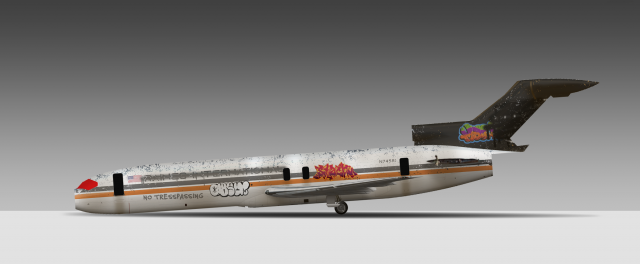
The Bankruptcy of Raines Air Systems
- Owner: crossfire (View all images and albums)
- Uploaded: Jun 27 2022 08:50 AM
- Views: 687
- Album Raines Air Systems: A Complete History

After the tragic crash at Norfolk, the FAA fined Raines Air Systems and, along with the NTSB, blasted the Raines management for its' deplorable employee schedules and procedures. The negative media followed, which caused passenger numbers for Globexpress to plummet and faith in freight operations to waver. Determined to quiet outrage surrounding the airline, CEO Al Bangh would attempt to "appease" pilots and mechanics.
Negotiations between management and the pilots and mechanics began in September of 1999. Demands from these employees were clear cut: better pay, shorter working hours and the reinstation of precious benefits. They also demanded that the rapid expansion be halted, arguing that it would hurt the company's profits long term. Instead of finding a middle ground, Bangh would attempt to convince employees that these would harm the company and the changes put in place would make Raines Air "one of the most influential airlines in the cargo market." Employees would claim Bangh to be tone deaf because of these comments.
Chief Pilot Grayson Keith, a vocal advocate for joining a pilot's union, would meet Bangh in his office on September 24, 1999. Bangh's secretary would record the confrontation.
"You're meaning to tell me that this company has gained 15 million in profits, and none of those can be given to improve life for your hardworking employees?" Keith would question Bangh.
"Those profits," Bangh responded, "are going to increase our market share. We are already the largest cargo airline at Miami and we could even top JFK. We don't need these disruptions you've pushed so hard."
"Disruptions?! I'm looking out for my fellow coworkers! You can't do this by yourself, Albert! We fly and fix your planes, and you think you can just pay us pennies for that?!"
"I am the only one keeping this company afloat, Grayson! You should be happy I even pay you bastards with how much you bitch and moan. I'm not gonna let other people tell me how to run my company, including you!"
Keith was fired because of this exchange. His termination would trigger strikes among the employees of Raines Air. This resulted in several operational disruptions which hurt the company. These continued for several months until it was discovered in July of 2000 that the company was hiring strikebreakers, which added fuel to the fire and increased strikes. By November, 60% of Raines' contractors had pulled out due to increasing cancellation of flights. All the while, resentment between the management and the employees continued to grow. Grayson Keith would plead employees to cooperate, with no response.
After failing miserably to meet the 2000 holiday economic goals, Raines Air Systems finally filed for Chapter 11 bankruptcy protection on the night of February 16th, 2001. Instantly, all service was suspended and planes were left stranded at the airport. 30 percent of the workforce was laid off immediately, and Globexpress was officially shut down permanently. The airline put many of it's older planes for sale, such as it's 727s, DC-9s and the remaining DC-8s. Many of these would be stored for weeks after the bankruptcy.
Some would be stored indefinitely. N745RI was a Boeing 727-200 that served with Japan Airlines before it was delivered to Raines in 1988. When the airline declared bankruptcy, it was at Nashville Airport. It was stored on the apron until it could find a buyer. After 3 weeks, the aircraft was repossessed by the City of Nashville and towed to a grassy site east of Runway 2R. It was stripped of any valuables and left there. For over 20 years, it remained at the site, exposed to the elements, rusting with paint flaking from hail damage and sunlight. Vandals found their way to the aircraft which led to efforts to stop it, to no avail. In October of 2021, it was announced the aircraft would be scrapped, but it has yet to have gone through.
N945F was a DC-9 that had a happier fate. It was stuck at Indianapolis and was claimed by the city, who would donate the airframe to Purdue University. The aircraft would make it's final flight to Purdue University Airport on May 2nd, 2001. It was parked at the apron and partially repainted into a Purdue color scheme. It would be used to teach students about aeronautical technology, aviation administration and flight technology. After Southwest donated a 737-300 in 2016, N945F was demolished on site on January 18th, 2017.
In one night, Raines Air seemed to unravel, and the future became uncertain.

 Sign In
Sign In Create Account
Create Account













Great job (again) on the lore and on the template modification